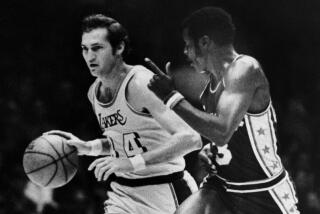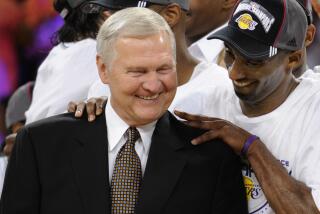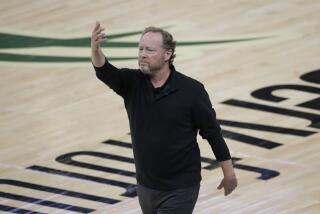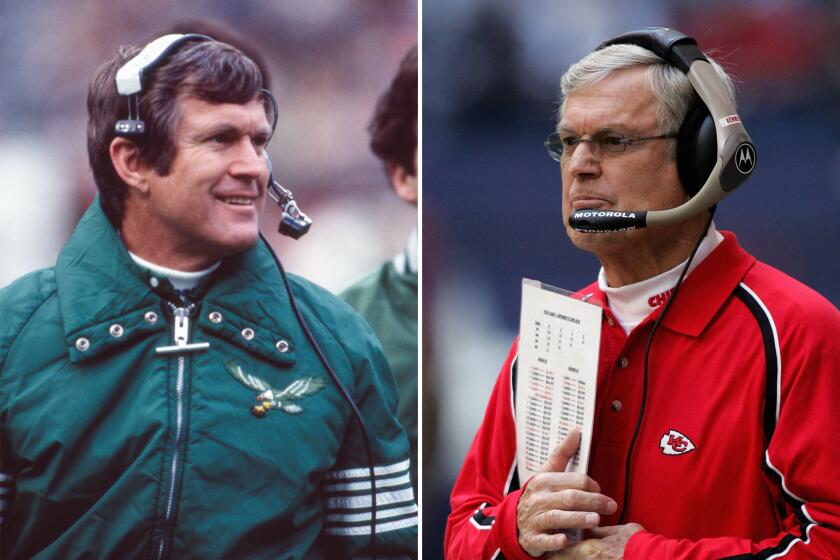Long Odds, but a Good Bet
- Share via
PHOENIX — So the Suns are a longshot, trailing, 2-0, in the Western Conference finals ... and going to San Antonio for the next two games. So what?
Steve Nash’s career has been a longshot and one that came in. Of course, that’s not as much a surprise to him as it is to everyone else, even if he does look like a mascot or a long-haired refugee from a YMCA league, since he has been great at every game he played, including this one.
Nor is it that surprising to Nash that after a lifetime of passing off while scoring a modest 12.8 points a game, he’s now putting up superstar numbers nightly, 25 points a game in the playoffs.
Of course, even for Nash, becoming the most valuable player at 31, after eight seasons in which he was never on the first or second All-NBA team, is more than even he imagined.
Now he’s one of the big guys. OK, one of the smaller big guys.
“I kind of laugh at it,” the 6-foot-3, 195-pound Nash says. “I always kind of feel I’m the underdog so I don’t consider myself being in that company. It kind of makes me laugh to think I’ve accomplished some of the things I’ve accomplished.”
It’s a laugh riot. The NBA has had MVPs as big as Shaquille O’Neal, as round as Charles Barkley, as defined as Karl Malone and as transcendent as Michael Jordan, Magic Johnson and Larry Bird, but it never had one who was configured like Nash, who is not only small and slow but Canadian.
All the other superstars emerged before they turned 30 too. Nash was so far out of profile for an MVP, his selection prompted questions about whether the vote, in which he edged out O’Neal, had been racially tilted.
Actually, it had. According to the Arizona Republic, which canvassed most of the voters, minority voters tilted toward Nash.
Then, of course, Nash went into his five-game roll (32 points and 11 assists a game, shooting 59% while leaving the floor for a total of 23 minutes) and people stopped asking how he got to be the MVP.
“That’s the big misconception,” says Alvin Gentry, the former Clipper coach who is a Sun assistant. “He’s a hell of an athlete. The guy’s a hockey player, a great soccer player. He can play anything....
“I’m sure, him being Canadian, if he was a curler, he’d be a great curler. I think he’d be the little guy with the broom.”
No one would probably take him seriously in curling, either. He would probably show them there too.
From the Ashes,
Time and Again
Appropriately enough, for a team from a city named after the mythological bird that rose from its own ashes, the Suns’ history is all about re-creating themselves.
The team’s history is interchangeable with that of the Colangelo family, but this isn’t just the usual sports success story.
Jerry, the father, once an All-Big Ten Conference point guard at Illinois who had worked in the Chicago Bulls’ front office, arrived here in 1968 to run the new expansion franchise. A poor boy from the working-class Hungry Hill section of Chicago Heights, he worked his way up as scout, general manager and even coach for two interim stints, running an old line-basketball-savvy organization that was notable for its family feel.
The front office is still full of former players such as Mark West, Dick Van Arsdale and Connie Hawkins. Phoenix became a destination, one of those places players wanted to come to and stay in after they retired.
Colangelo had modest resources but shrewd instincts. When a drug-and-gambling scandal blew up in 1987, at least in the newspapers, the owners wanted out. Colangelo put together a group that bought the franchise for $44 million.
After that, he built America West Arena (mostly with public money), revitalizing the sleepy downtown area and serving as the model for new NBA buildings.
Then he spearheaded the drive to bring the Diamondbacks to town and got Bank One Ballpark built. After one season, when season-ticket revenue unexpectedly fell 25%, he talked his partners into going for broke, no matter what it cost.
The Diamondbacks won three division titles and in their third season, the 2001 World Series.
The price turned out to be Colangelo’s job. In 2004, with the team in dire financial straits, he was forced out by his partners.
By then, Colangelo was wealthy, but he wasn’t just a sports owner. He was responsible for half of downtown Phoenix and considered one of the most powerful men in the state. The Phoenix Business Journal named him its top businessman for five years running. His name was mentioned as a candidate for governor and the U.S. Senate.
Meanwhile, back in America West Arena, the Suns were still rising and falling. In Colangelo’s first season as owner, they got Kevin Johnson from Cleveland, signed Tom Chambers and went from 28 wins to 55. In 1993 with Barkley, they reached the NBA Finals but lost to the Bulls on John Paxson’s shot at the end of Game 6, which was all that stood between the Suns and playing Game 7 at home.
When Barkley left, the Suns got Dallas to trade them Jason Kidd, launching a new era. However, it turned out to be a short one, marred by Kidd’s arrest for domestic abuse. Colangelo was a major figure in the local anti-domestic violence cause and Kidd was traded for Stephon Marbury.
Marbury’s era was even shorter. In his third season with losses mounting, costs rising and seats emptying, he was traded to the New York Knicks in a meltdown deal, designed only to give the Suns cap space so they could start all over.
This was engineered by Colangelo’s son, Bryan, who had become the general manager. That summer, the Suns signed Nash and went from 29 wins to a league-best 62. Even for them, that was fast.
By then Jerry had cashed out, selling the team for $401 million to local businessman Robert Sarver but retaining operating control for three seasons. Sarver caused a stir with his courtside antics, as when he flapped his arms like a chicken to protest when Tim Duncan sat out a game here because of an ankle injury. However, Sarver also pledged to keep the current management team, with Bryan as general manager. Bryan was named the Sporting News’ executive of the year.
For his part, Jerry was just named to run the U.S. Olympic basketball program. It’s a dream ending, except for this series.
The All-American
Boy From Canada
Appearances notwithstanding, Nash wouldn’t be your typical All-American boy-next-door, even if he weren’t Canadian.
Whoever Nash is, it isn’t what he looks and sounds like. In interviews, he’s cooperative but guarded and bland. He’s happy to talk about basketball but shows little emotion.
On the other hand, in his time he has been paired with actress Elizabeth Hurley (he says “dated” is the wrong word but “item” is OK) and singer Geri Halliwell, aka Ginger Spice. He wore an anti-war T-shirt at last season’s All-Star weekend but was bashed for it with David Robinson coming out against him. Nash has been even more guarded since.
With one scholarship offer, from Santa Clara, coming out of Victoria, Canada, Nash made himself into a pro prospect. The Suns took him with the 15th pick in the 1996 draft but after two seasons waiting his turn behind Kidd and Kevin Johnson, he asked to be traded.
The Suns dealt him to Dallas, where he was hurt and/or disappointing for two seasons. Then, in a Phoenix-like turnaround, Coach Don Nelson got him to take the shot when he had it and the floor opened up before him.
By last summer, he was a two-time All-Star and a free agent. The Suns offered him a $65-million deal to return. Nash listened but called Dallas owner Mark Cuban, asking if he would match it. Cuban had decided he wanted a more conventional, non-Nelson approach and passed.
As Rex Chapman, a Sun official and Nash’s friend, told the Republic’s Paul Coro, when Nash got the news, “It was like someone just put a bullet in his chest.”
Nash doesn’t say much about the Mavericks. Of course, he did average 30 in the last series against them.
Tired of watching Nash slip the ball to Amare Stoudemire on pick-and-rolls for tomahawk dunks, opponents have begun sagging on Stoudemire while sticking to the other three Suns spotted up on the arc for three-pointers, letting Nash come free in the lane.
So Nash, a career 41% shooter on three-pointers and 89% on free throws, is knocking down 10-footer after 10-footer.
“It’s really just what needs to be done,” he says. “When you go into the playoffs, you’re trying to give yourself the best opportunity to help your team as much as you can. You hope you’ll get on a roll and do my part while I’ve got it going here.”
Nash became the MVP this season while averaging only 15.5 points but a league-leading 11.5 assists. Is this an aberration for him, a delusion or another new level?
“I don’t want to be pompous or think we’ve got it figured out,” says Coach Mike D’Antoni. “I don’t know how you guard Amare and Steve Nash on the pick-and-roll. I don’t know if it’s possible. Now, it hasn’t been possible all year. We’ve had 90 games and it hasn’t been possible....
“I don’t know if he [Nash] can keep these numbers up all the time but if they get together for a couple years, I don’t know why Steve can’t be 25 points and 15 assists. He might do that all the time, I don’t know.”
As if there haven’t already been enough surprises in this career, Nash may not be done.
More to Read
Go beyond the scoreboard
Get the latest on L.A.'s teams in the daily Sports Report newsletter.
You may occasionally receive promotional content from the Los Angeles Times.










